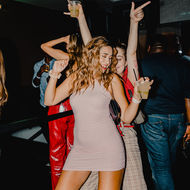The Impact of Social Media on the Beauty Industry: How Social Media Shapes Beauty Trends and Consumer Behavior
- Kgopotso Msimanga

- Dec 13, 2024
- 4 min read
In the digital age, social media has become a driving force in the beauty industry, influencing not only the way consumers discover new products but also how they perceive beauty standards and trends. Platforms like Instagram, TikTok, YouTube, and Twitter have revolutionized the way beauty brands and consumers interact, creating a dynamic, fast-paced environment where trends emerge overnight and consumer behavior shifts rapidly. Let’s explore how social media has reshaped the beauty landscape and continues to drive industry change.

The Power of Influencers and Content Creators
One of the most significant impacts of social media on the beauty industry is the rise of influencers and content creators. Platforms like Instagram and YouTube have given rise to individuals who are not only showcasing their beauty routines but also shaping the way consumers approach beauty products and services. These influencers often have large, dedicated followings, and their opinions can sway purchasing decisions.
In many cases, influencers have replaced traditional advertising in beauty marketing. A glowing review or tutorial from a well-known influencer can lead to skyrocketing sales for a product, while negative feedback can have the opposite effect. The ability for consumers to interact directly with influencers, ask questions, and get real-time responses has fostered a sense of trust and relatability, which has enhanced the credibility of beauty recommendations.
The Emergence of Beauty Trends
Social media platforms, particularly Instagram and TikTok, are now the breeding grounds for beauty trends that can go viral within hours. Whether it’s a new makeup technique, a skincare routine, or a bold new hair color, trends on social media spread rapidly as users share their experiences and inspire others to replicate them. The "challenge" culture, especially on TikTok, has contributed to the rapid virality of beauty trends, with users often posting videos demonstrating the latest product or technique, encouraging others to join in.
For instance, the "glass skin" trend popularized by K-beauty influencers spread quickly across the globe through social media, influencing the way consumers approach skincare. Similarly, makeup trends like the "eyebrow lamination" or the "cut crease" have gained massive popularity due to social media tutorials and viral videos. Trends often evolve at lightning speed, with new looks and techniques popping up and disappearing just as quickly, challenging beauty brands to keep up.
Democratization of Beauty and Inclusivity
Social media has played a crucial role in pushing for diversity and inclusivity in the beauty industry. Historically, beauty standards were largely defined by traditional media outlets, with limited representation of different skin tones, body types, and gender identities. However, social media has created a platform for a wider range of voices, giving individuals from various backgrounds the opportunity to showcase their beauty and connect with others who share similar experiences.
The rise of inclusive beauty brands, which cater to all skin tones, genders, and body types, is a direct result of this shift. Beauty brands are now more aware of the need for diverse representation in their campaigns, with influencers and consumers demanding better representation of ethnicities, body types, and abilities in the beauty narrative. Social media also allows consumers to share their own beauty stories and experiences, leading to greater acceptance and the breaking down of traditional beauty norms.

Instant Access to Product Information and Reviews
One of the biggest benefits of social media in the beauty industry is the instant access to product information and reviews. Consumers no longer need to rely solely on advertisements or word of mouth to decide which products to buy. Instead, they can go online, scroll through user-generated content, and find honest reviews from real people who have already tested the products.
Beauty brands have embraced this shift by engaging with their audiences directly on social media platforms, answering questions, addressing concerns, and sharing user-generated content. Platforms like Instagram Stories, Reels, and TikTok have given brands the ability to showcase their products in a more authentic and engaging way, allowing consumers to see how products perform in real-life scenarios rather than relying solely on polished, professional images.
The Shift Toward Direct-to-Consumer Models
The rise of social media has also paved the way for the growth of direct-to-consumer (DTC) beauty brands. These brands leverage social media platforms to bypass traditional retail channels, selling directly to consumers through their own websites or apps. This approach allows beauty brands to maintain control over their brand image, connect directly with their customers, and collect valuable data to improve their offerings.
By building a strong social media presence, DTC beauty brands can engage with their audience, create brand loyalty, and build a community around their products. Many successful beauty brands, such as Glossier, Fenty Beauty, and Huda Beauty, have thrived thanks to their strategic use of social media marketing, influencer partnerships, and user-generated content.
Social Media and Consumer Behavior: A Shift Toward Authenticity
As social media continues to evolve, consumers are becoming more discerning when it comes to the beauty content they consume. There has been a noticeable shift away from overly polished, edited images toward more authentic, "real" content. Users are gravitating toward influencers and beauty brands that embrace transparency and authenticity, with a focus on realistic beauty standards and genuine experiences.
For instance, many beauty influencers now share their skincare journeys, imperfections, and struggles with products, offering their audiences a more authentic and relatable view of beauty. Brands are responding to this demand by showcasing a wider range of models, addressing customer feedback, and promoting messages of self-love and acceptance.

The Ongoing Evolution of Social Media’s Influence on Beauty
Social media has undoubtedly reshaped the beauty industry in profound ways. From shaping trends to fostering inclusivity and authenticity, the power of social media in the beauty world is undeniable. As platforms evolve, and new technologies emerge, social media will continue to drive how consumers discover, engage with, and purchase beauty products.
For beauty brands, embracing social media is no longer optional – it’s essential for survival and growth. As consumer expectations continue to shift towards authenticity and inclusivity, the beauty industry will need to keep innovating and adapting, using social media as a tool to connect with their audience and stay ahead of the curve.
































Comments